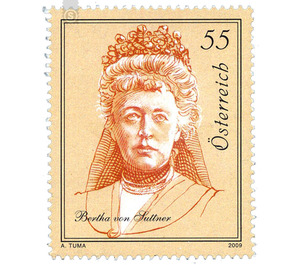120 years - Austria / II. Republic of Austria 2009 - 55 Euro Cent
Theme: Art & Culture
| Country | Austria / II. Republic of Austria |
| Issue Date | 2009 |
| Face Value | 55.00 |
| Edition Issued | 900,000 |
| Printing Type | offset |
| Stamp Type | Commemorative |
| Item Type | Stamp |
| Chronological Issue Number | 2163 |
| Chronological Chapter | OOS-OE2 |
| SID | 47549 |
| In 54 Wishlists | |
When Countess Bertha Sophia Felicita Kinsky was born on 9 June 1843 in Prague by Chinic & Tettau, no one suspected that she was the world's most famous Austrian of the 19th century. would be. The father, Count Franz Josef Kinsky died before birth, so that the training was in the hands of the mother. She spent her childhood and adolescent years in Prague, Brno and Vienna. Unfortunately, the mother, Countess Sophie Kinsky, was a player who wasted all her fortune. Both ladies traveled in Europe from 1860 from a fashionable seaside resort to another. After 1873, no money was left, Bertha Governessante was at Baron von Suttner for his four daughters. The son Arthur and Bertha fell in love but much to the annoyance of the parents. In 1876 Bertha had to give up this post. She then worked briefly in Paris for Alfred Nobel, the dynamite king, as a secretary. On June 12, 1876, she secretly married Arthur Gundaccar von Suttner in Vienna. To avoid the parents, they went to Princess Ekatarina Dadiani to Mingrelien in western Georgia, where they spent nine years of hard work until 1885. During this time, both developed their literary and journalistic skills so far that they were able to live from the fees after returning to Austria. Berta increasingly devoted herself to pacifism. At a writers congress in Paris, they met the two leading men of the peace movement: Hodgson Pratt and Frederic Passy. From then on, the idea of peace never left her. After working at Harmannsdorf Castle, she worked intensively for this peace idea. Among other things, Bertha had begun a novel against the war, which she now completed: "Arms down!" In autumn 1889, the first edition came on the market - the book became a world bestseller! Hundreds of thousands of copies in 16 languages were sold. As a pacifist, Bertha von Suttner was the number one topic of discussion worldwide - much to the annoyance of militant circles and the armaments industry. Their conviction: mass murder can not solve any problems. Some novels and many newspaper articles followed. Her husband Arthur died in 1902, a grave loss that even the Nobel Peace Prize of 1905 could not comfort. She kept writing articles and lecturing in Europe and America. On June 21, 1914 she died in Vienna, where she lived since 1903. Seven days later, the successor to the throne was murdered in Sarajevo - the First World War began. Millions of dead, blood, suffering and tears confirmed their warning: Down the gun!


